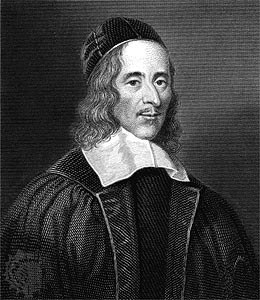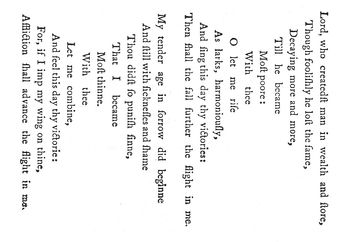The poem “Easter Wings” by George Herbert is a poem full of deep imagery not only in its words but also in the visual structure of the stanzas. In Herbert’s poem why does he use a shape poem? Because he wanted this poem to have many different levels and meanings.
Herbert also used huge amounts of mental imagery so that the reader can find new truths and meanings each time he or she reads it. The poem tells of the poets desire to fly with Christ as a result of Jesus’ sacrifice, death and resurrection. The argument as to the proper presentation of this poem is easily explained with the help of the poet’s address to the “Lord” in the opening line of the first page in the original text.
Because this poem is actually a work within a work with many hidden meanings and suggestions. To fully understand it all, one must examine the poem as a whole in greater detail. The poet is the obvious speaker in the poem due to the common use of “I” and “me” through out the poem.
The audience is also revealed in the first line of the 1634 edition of the poem with the use of the word “Lord”; meaning the Christian Savior, Jesus Christ who rose from the dead. But there is question as to where the poem truly begins. This is due to the splitting of the poem onto two separate pages, and then turned ninety degrees so it must be read sideways.
This is done on purpose to invoke the vision of wings on both pages. This fact must be considered when evaluating where it begins and whether it is in fact two poems instead of one larger one. “Lord, who createth man in wealth and store” is the beginning of this poem, helping to immediately establish the audience in the first word. As well, this fact helps to reveal that this poem is also a prayer of Herbert’s. The appropriate layout of the poem is still the “winged” look necessary for the full impact of the imagery.
It is the imagery in this poem that deserves special notice as it gives a much deeper understanding of what Herbert is saying. The first stanza shows the fall of man from the “wealth” that is in God’s holiness into the “decaying” life of a sinful nature: “Lord, who createst man in wealth and store, Though foolishly he lost the same, Decaying more and more Till he became Most poor:” As the stanza’s lines “decays” in length, the imagery goes from good to bleak finally ending with the eventual poorness of mankind. In the first line where it shows how man was born into abundance with full potential.
Yet somehow managed to abuse this potential in habitual sin and so abuse the gift that God had bestowed upon us. As one reads the first stanza, one feels it dwindle and wither away into nothingness; this verse does, indeed, decrease both in emotion and context.
At first reading this poem you may not see the complex correlation between the shape and the actual meaning of the poem. Herbert intended this in his poem probably to attach a reader to his poem to find the true meaning as to why this poem was in this shape and has lines large in size and then they decline.
But then the emotion in the poem picks up steam again in the next stanza and gains the size and exact structure the first stanza but in opposite order, from small to large. The second stanza of the poem is turning in emotion and finishing with the poet taking “flight” and completing the second wing: “With thee O let me rise As larks, harmoniously, And sing this day thy victories: Then shall the fall further the flight in me.” This stanza is rich in imagery.
It seems like this stanza “beats its wing” against the decline of the first stanza, showing how the “fall” of man “furthered the flight” in Herbert as it paved the way for the crucifixion of Jesus. It was this action which redeemed man so they could have fellowship with God again. While in the first stanza you see Herbert using he and the word man, where as in the second stanza the poem becomes more personal to Herbert when he uses me. This part of the poem could be meant as the personal prayer to god thanking him for the death of his son and our salvation .
Also of note is the use of “larks, harmoniously” to give a beautiful, resonate feel to the poem; opposite to that of words like “decaying” and “most poor” used in the first stanza.
The first three lines of the second stanza, “With thee/ O let me rise/ As larks, harmoniously” tells us Herbert wants to be with Jesus in the air during the resurrection. the word harmoniously suggests there is more than one voice singing. Since harmonies are known to work in three’s, this would support the Christian view of the Trinity, saying that Herbert would like to rise “as larks”; the Father, the Son, and the Holy Spirit.
The second page of the poem is very much the same as the first. Some would suggest that it is a separate poem all together, but when noticing that the voice and audience carry over from the first page it is easier to understand that the poem is just continuing.
As the first stanza spoke of the “fall” of man into sin, the third stanza becomes more personal to the poet as the turn was made back in the overall attitude in the second stanza: “My tender age in sorrow did beginne: And still with sicknesses and shame Though didst so punish sinne, That I became Most thinne.”
Once again, this stanza decreases every line like that of the first. The first line tells of Herbert’s sorrowful beginning and then continues with giving the reader the understanding that Herbert was not free of the punishment of sin as he became “most thinne”. It is this ending that gives the reader the sense of a partial end; a loss of purity.
Herbert illustrates this depletion in human character visually. Ideally, our virtues and wisdom should grow with age; Herbert is somber in exclaiming that this is not necessarily the case. With the passage of time, the poet expresses that his only gain was that of guilt and compounded sin. To witness sin, perchance, is a sin in itself, thereby making it impossible to live a life of isolated purity. Again the poet picks up from where he left off and begins the next stanza with words of rejuvenation.
However, this stanza adds an element of connection: With thee Let me combine, And feel this day thy victorie; For, if I imp my wing on thine, Affliction shall advance the flight in me.” Again, Herbert turns to his Lord so he can be a part of the victory. This time though, Herbert wants to “combine” with Jesus, to be grafted on His wing. This, unlike the third stanza, moves Herbert even closer to Jesus.
This would suggest he doesn’t want to be only “with” Jesus but grafted “onto” Jesus, thus a much closer relationship would result between the two. One will notice that the first and third stanzas seem to resist or go against that of the second and fourth stanzas. I think Herbert did this appropriately to show how the course of man’s action (and not excluding Herbert himself), led to the affliction and fall of man.
It is this affliction and fall which furthers Herbert’s flight as it is the reason why Jesus suffered, died and resurrected; to free man of the chains of sin and death. This is where the resistance is seen. It is difficult for one to see how negatives such as “affliction” and “fall” could lead to glory but it is this resistance, much like that of a wing beating against the resistance of gravity and air, that furthers not only the flight of the poet but also that of mankind.
In other words, without man’s falling into sin there would have been no reason for Jesus to have suffered and died on the cross. After careful examination of Herbert’s poem, one can see the winged imagery throughout, and understand why Herbert used such shape and imagery. Herbert wanted to show people of his time and from then on many truths in one poem.
Not only does the shape and imagery have a great effect on the reader, but the emotional swings and shifting play many “tricks” on the reader as we go through Herbert’s poem. Also, Herbert’s original presentation is most unusual and confronts the reader with an awkward dilemma. In order to access the words of his poem, the book must be turned ninety degrees. This turning of the book could be Herbert’s way of changing our point of view.
If God’s resurrection truly changed the world, as Herbert believed, then he wanted even our reading habits to reflect that difference. Furthermore, this physical act of turning requires a decision. Since, biblically speaking, God does not enter unless invited, our act of turning the book reflects our freedom of choice and God’s response is initiated.
That how man’s decline because of sin was defeated by the actions of the cross. So the point of Herbert’s work “Easter Wings” May not actually be obtainable just with one reading, or for that case many readings. But Herbert did show us that using shape and imagery throughout his poem that many different meanings and points can be made within one poem.
He also helped us to understand what he viewed as right and wrong, he used imagery throughout his poem to give us a sense into his life and his value system. In doing so he gave the readers of his poems a chance to find all of the truths and meanings in his poem.
Lastly in Herbert’s poem he wants us to be grateful of the gift that God has given to us, by allowing his only son to die for the salvation of our sins to make us washed clean with grace, it is this action which allows all of mankind, and not just Herbert, to be grafted into Jesus’ wing to “further the flight” in us all.



Very good